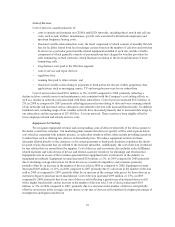Sprint - Nextel 2008 Annual Report Download - page 49
Download and view the complete annual report
Please find page 49 of the 2008 Sprint - Nextel annual report below. You can navigate through the pages in the report by either clicking on the pages listed below, or by using the keyword search tool below to find specific information within the annual report.OFF-BALANCE SHEET FINANCING
We do not participate in, or secure, financings for any unconsolidated, special purpose entities.
CRITICAL ACCOUNTING POLICIES AND ESTIMATES
Sprint applies those accounting policies that management believes best reflect the underlying business
and economic events, consistent with accounting principles generally accepted in the United States. Sprint’s
more critical accounting policies include those related to the basis of presentation, allowance for doubtful
accounts, valuation and recoverability of our equity method investment in Clearwire, valuation and recoverability
of long-lived assets, evaluation of goodwill and indefinite-lived assets for impairment, and accruals for taxes
based on income. Inherent in such policies are certain key assumptions and estimates made by management.
Management periodically updates its estimates used in the preparation of the financial statements based on its
latest assessment of the current and projected business and general economic environment. These critical
accounting policies have been discussed with Sprint’s Board of Directors. Sprint’s significant accounting policies
are summarized in Note 2 to the Consolidated Financial Statements.
Basis of Presentation
The consolidated financial statements include the accounts of Sprint and its consolidated subsidiaries.
Investments where Sprint maintains majority ownership, but lacks full decision making ability over all major
issues, are accounted for using the equity method. Governance for Sprint’s major unconsolidated investment,
Clearwire, is based on Clearwire board representation for which Sprint does not have a majority vote.
Allowance for Doubtful Accounts
We maintain an allowance for doubtful accounts for estimated losses that result from failure of our
subscribers to make required payments. Our estimate of the allowance for doubtful accounts considers a number
of factors, including collection experience, aging of the accounts receivable portfolios, credit quality of the
subscriber base, estimated proceeds from future bad debt sales and other qualitative considerations. To the extent
that actual loss experience differs significantly from historical trends, the required allowance amounts could
differ from our estimate. A 10% change in the amount estimated to be uncollectible would result in a
corresponding change in bad debt expense of about $20 million for the Wireless segment and $1 million for the
Wireline segment.
Valuation and Recoverability of our Equity Method Investment in Clearwire
We assess our equity method investment for other-than-temporary impairment when indicators such as
decline in quoted prices in active markets indicate a value below the carrying value of our investment. This
evaluation requires significant judgment regarding, but not limited to, the severity and duration of decline in
market prices; the ability and intent to hold the securities until recovery; financial condition, liquidity, and near-
term prospects of the issuer, specific events, and other factors. Sprint’s assessment that an investment is not
other-than-temporarily impaired could change in the future due to changes in facts and circumstances.
Sprint owns a 56% ownership interest in Clearwire for which the carrying value as of December 31,
2009 was $4.3 billion while the value of such investment based on Clearwire’s closing stock price was $3.5
billion. Sprint continues to believe that we will fully recover the carrying value of our investment.
Valuation and Recoverability of Long-lived Assets
Long-lived assets consist primarily of property, plant and equipment and intangible assets subject to
amortization. Changes in technology or in our intended use of these assets, as well as changes in economic or
industry factors or in our business or prospects, may cause the estimated period of use or the value of these assets
to change.
Property, plant and equipment are generally depreciated on a straight-line basis over estimated
economic useful lives. Certain network assets are depreciated using the group life method. Depreciable life
studies are performed periodically to confirm the appropriateness of depreciable lives for certain categories of
47
























